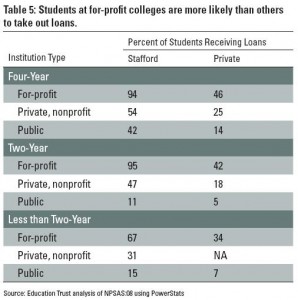“Subprime Opportunity: The Unfulfilled Promise of For-Profit Colleges and Universities”
A new Education Trust report published this past week criticizes for-profit institutions for their low graduation rates, expensive tuition costs, and aggressive recruiting tactics. The authors reveal in the report that students at for-profit schools borrow a large amount of money for their education, yet only a small percentage earn a “marketable degree or credential.”
The most alarming statistic revealed in the report states that a mere 22 percent of students at for-profit schools graduate within six years, compared to 55 percent of students at public institutions, and 65 percent of students at private non-profit institutions.
The high cost of a low education
Tuition at for-profit institutions costs approximately $25,000 a year, but with a 22 percent chance of graduating, the costs can be devastating for students or even graduates.
Only 4 percent of students who earn bachelor’s degrees at for-profit schools graduate debt-free, compared to 38 percent of students at public institutions, and 28 percent of students at private non-profit institutions.
Default rates at for-profit institutions are also twice as high as the default rates at public and private non-profit colleges, with for-profit institutions representing 43 percent of all federal student loan defaults.
“[The] Students’ inability to pay back the debt strongly suggests that the credentials students are earning at these schools, with the intention of preparing themselves for lucrative jobs and careers, may not be worth the cost,” the authors write.
Approximately 10 percent of all students who study at for-profit institutions end up defaulting on their federal student loans within two years, and 19 percent of students default within three years. As a result, many of these students and/or graduates may have their wages “garnished,” their income tax refunds intercepted, or even their Social Security payments withheld.
Are for-profit schools failing low-income and minority students?
 For-profit institutions have always stated that their recruitment of low-income and minority students is “heralded as a sign of its commitment to underserved populations.” But the authors of the report state that low-income and minority students, (who are pursuing college degrees in record numbers), are targeted and then “recruited aggressively” by for-profit colleges. (Low-income students represent 50 percent of the student population at for-profit schools, while minority students make up 37 percent).
For-profit institutions have always stated that their recruitment of low-income and minority students is “heralded as a sign of its commitment to underserved populations.” But the authors of the report state that low-income and minority students, (who are pursuing college degrees in record numbers), are targeted and then “recruited aggressively” by for-profit colleges. (Low-income students represent 50 percent of the student population at for-profit schools, while minority students make up 37 percent).
The authors also explained that low-income and minority students are more likely to take out student loans at for-profit colleges than at any other institution.
“For-profit colleges argue that they are models of access and efficiency in America’s overburdened higher education system,” write the authors. “But instead of providing a solid pathway to the middle class, they are paving a path into the subbasement of the American economy. They enroll students in high-cost degree programs that have little chance of leading to high paying careers, and saddle the most vulnerable students with more debt than they could reasonably manage to pay off, even if they do graduate.”
Click here to read the report:
“Subprime Opportunity: The Unfulfilled Promises of For-Profit Colleges and Universities“



 In the second instance, he was pictured in a “battered Ford Fiesta.”
In the second instance, he was pictured in a “battered Ford Fiesta.” Dunn noted this in both instances, this was an evolutionary and not a social trait. He stated:
Dunn noted this in both instances, this was an evolutionary and not a social trait. He stated: